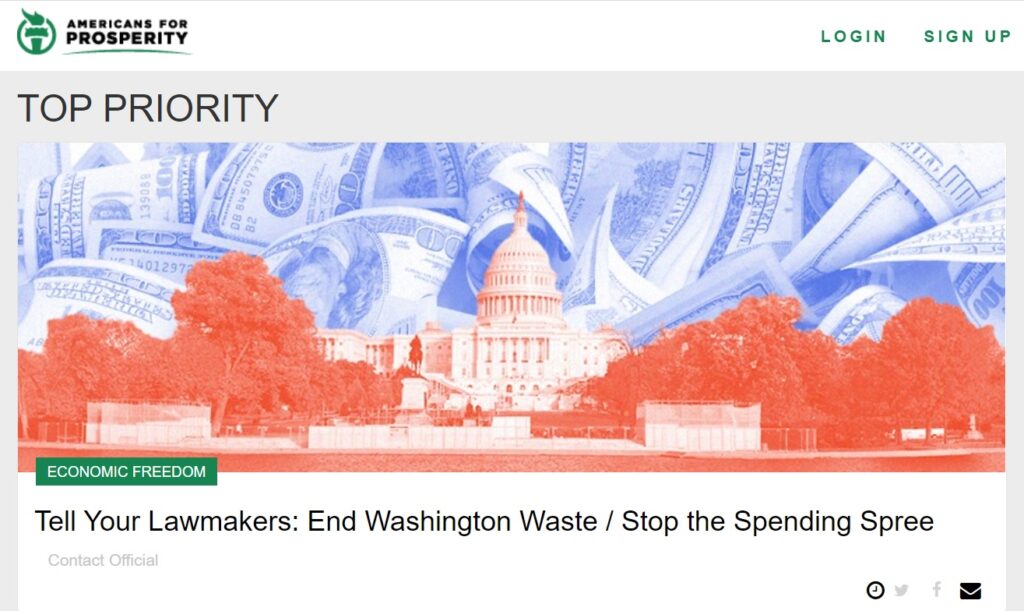
Infrastructure spending bills have a long history of waste, embarrassment
The White House and leaders in Congress seem determined to pass a massive bill intended to boost “infrastructure,” at a spending level that’s unprecedented for such an effort.
Unfortunately, it includes little spending actually related to infrastructure.
This isn’t the first time in recent history that spending bills disguised as infrastructure bills have been criticized in this way.
- In 1998, President Clinton and Congress worked together on a $217 billion transportation bill.
- Who can forget President George W. Bush’s 2005 bill that included funding for the infamous Bridge to Nowhere.
- President Obama’s 2009 “American Recovery and Reinvestment Act” had an $831 billion price tag.
- The Trump Administration proposed or endorsed several costly infrastructure plans between 2015-2020.
- If President Biden’s recent proposal gives you déjà vu, you’re not alone. His promises sound familiar to us, too.
While presidents and congressional leaders have defended the big price tags and claimed that the bills were not wasteful, history has rendered a different verdict.
In a number of instances, the elected officials who advocated these measures have wound up looking silly.
‘Regular’ transportation bills
Federal transportation spending programs are not permanent. Congress and the president must come together regularly to extend the legal authorization and funding for these programs when they expire. These highway bills remain in place for several years, and permit the federal government to distribute aid to states for numerous transportation programs.
While these bills are considered regularly, there is always extensive debate around spending levels, earmarks, waste, and “unrelated” spending. Below are a few recent examples.
1998: $217 billion for a transportation bill with 1,850 separate pork projects
President Bill Clinton and congressional leaders came together on a six-year, $217 billion transportation bill. It included a reported 1,850 separate earmarks for individual projects – a sharp increase from the 538 included in the 1991 highway legislation.
In the face of criticism and ridicule related to the inclusion of so many earmarks, the legislation referred to these costly mandates as “high priority” projects.
In this bill, the high priorities included things such as bike paths and upgrades to an interpretive music center. Those projects wound up attracting negative media attention
2005: Remember the Bridge to Nowhere? That would’ve cost $223 million
In 2005, President George W. Bush signed SAFETEA-LU, a four-year, $286 billion transportation bill. It reportedly earmarked funding for 6,000 lawmaker projects, and critics call it a “bloated, expensive bill.”
One of the projects funded was the Gravina Access Project – a $223 million bridge to connect Alaska’s tiny Gravina Island (population: 50) to Ketchikan.
The project was ridiculed as a “Bridge to Nowhere” and was eventually killed by state officials in 2015. But in the meantime, critics had a field day pointing out the waste and ethical conflicts associated with the bill and the process.
More recently, candidates for president appear to have decided that the traditional congressional process doesn’t allow for enough spending on transportation and infrastructure.
Each of the last three presidents won the White House while advocating a special, one-time spending bill dedicated to “infrastructure.”
The stimulus/infrastructure effort led by President Barack Obama sounds strikingly similar to the current initiative by President Joe Biden.
2009: The $831 billion ‘American Recovery and Reinvestment Act’
During the 2008 presidential campaign, Obama called for passage of an infrastructure and economic stimulus package, of which $50 billion – more than one quarter of the $175 billion in total spending – would go to states for roads and infrastructure.
In a post-election speech, Obama offered details and promises that might sound familiar:
We’ll put people back to work rebuilding our crumbling roads and bridges, modernizing schools that are failing our children, and building wind farms and solar panels, fuel-efficient cars and the alternative energy technologies that can free us from our dependence on foreign oil.
That package eventually grew into the massive, $831 billion “American Recovery and Reinvestment Act,” (ARRA) signed into law in February, 2009.
- The infrastructure portion of the bill shrunk by about half – to less than 13 percent of the total.
- But even though infrastructure spending had become a very small part of a much more massive bill, Obama repeatedly vowed that there were lots of “shovel ready” projects that were on hold, awaiting funding.
When the ARRA was debated and passed, public opinion was mixed.
- Polls generally showed a majority in favor of the bill, but 41 percent of Americans said it would have been better to spend less.
- Only 19 percent said this spending would shorten the recession significantly. The year after it was signed, more than two-thirds of Americans said the bill was “a waste.”
The whole effort was ultimately haunted by the phrase “shovel ready,” which comedians used as a punchline and critics called a swindle.
- Just $48 billion of the total spending in the package went to infrastructure.
- The folly of corporate welfare energy funding was highlighted when Solyndra – which received $535 million in federal assistance – went bankrupt in a matter of months.
Before long, even Obama was making jokes about projects that were never actually shovel ready.
2015-2020: The Trump administration’s many trillion dollar proposals
When Donald Trump ran for president, he proposed a 10-year, $1 trillion infrastructure bill. Throughout his term, he repeatedly came back to the topic.
Trump proposed a $1.5 trillion bill in 2018, tentatively agreed to a $2 trillion package in 2019, included a $1 trillion bill in his budget in early 2020, and endorsed a $2 trillion infrastructure package in March, 2020.
Through it all, critics in Congress and elsewhere worried that such a large bill would inevitably include too much wasteful spending, and no bill was passed.
Déjà vu all over again?
In many ways, supporters of the 2009 ARRA came to regret the outcome.
Almost $1 trillion in taxpayer money was spent, and what people remember is how little went to infrastructure and how much was wasted – including on companies that went bankrupt.
And Biden is making promises that we have heard before:
-
“After decades of disinvestment, our roads, bridges, and water systems are crumbling. Our electric grid is vulnerable to catastrophic outages. Too many lack access to affordable, high-speed Internet and to quality housing. …”
-
“… the President’s plan will accelerate transformative investments, from pre-development through construction, turning “shovel worthy” ideas into “shovel ready” projects.”
-
“… Modernize our nation’s schools and early learning facilities.”
Will this infrastructure and economic stimulus debate wind up like so many others have in the recent past?
Add your voice to those calling on Congress to reject this tax and spend “infrastructure” plan.




